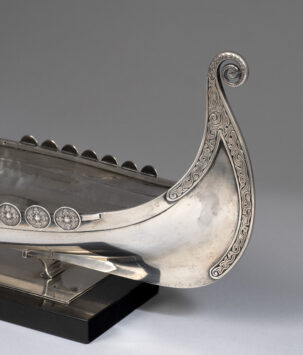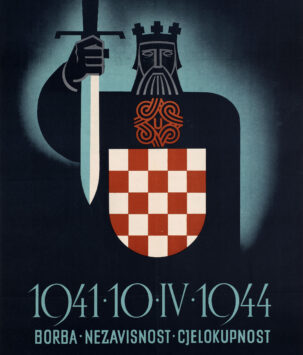Showing 1–12 of 16 results
-
Sculpture by Stanisław Szukalski as featured in the eponymous Netflix documentary, Struggle. Created in 1917, this piece depicts the infighting of the great powers of Europe during the First World War, with the hand representing European civilization. The opposing fingers, or nations of Europe, turn against one another failing to recognize they are but one.
-
Belgian recruitment poster for the Waffen-SS replacement troops. Illustrated by F. Bertau in 1944, the poster is unparalleled in its dynamism and visual literacy. The potent symbolism and cartoonish style make the piece both unique to the era and unlike any other from it. A visually entertaining poster that manages to non-verbally communicate all its intended ideas through its vivid composition and succinct symbolism.
-

Schutzstaffel (SS) recruitment poster from German-occupied Norway brimming with mythological imagery from Germanic Paganism. Found within this poster is a profound esoteric symbology that captures the essence of neopagan National Socialist cosmology. Combining the quadratic themes of each arm of the swastika presents a singular, divine whole. The horizontal axis represents temporality, with the left and right arms symbolizing past and present, respectively, while the vertical axis represents the theory of metaphysical dualism. An iconic element of Norway’s heritage, ancient Vikings warriors are reflected on the right by their modern descendants, legionnaires of the Norwegian Waffen-SS. In the center is the revered god of war, Odin. The cosmic tree Yggdrasil forms the top arm as the axis mundi of Norse cosmology, bridging the celestial realms to the terrestrial, rooted in our soil but with its branches reaching far into the heavens. A humble Aryan family and a valiant SS patriarch comprising the bottom arm can be seen defending his homestead from the ravenous dragon of Judeo-Bolshevism.
-
Silver longship awarded to SS-Obersturmbannführer Hans-Hendrik Neumann by Norwegian prime minister Vidkun Quisling for his advisory role during the German occupation.
-
Election poster promoting Norway’s far-right Nasjonal Samling (National Assembly) party, founded in May 1933 by Vidkun Quisling. The sun in the form of a pagan sun cross rises behind a raven which was veneratedin old Norse Viking mythology as Odin’s divine messenger. Akin to the German National Socialists they were modeled on, the Nasjonal Samling rejected Christianity and drew much of its imagery from paganism which they saw as a more authentically Norwegian faith. Although the party never enjoyed any electoral success, Quisling and his party collaborated with the Germans upon the invasion of Norway. Following his deposition in 1945, the very term ‘Quisling’ would later become synonymous with ‘traitor’ in the Scandinavian languages.
-
Poster celebrating the establishment of the Independent State of Croatia. An ethereal nimbus of light surrounds a king bearing the insignia of the Ustaše.
-
A potent Waffen-SS recruitment poster from the occupied Netherlands. A legion of stormtroopers march in unison surmounted by an array of artillery guns and lead by a platoon of tanks, all of which comprise an earthy foreground and gives the poster its sturdy visual foundation. The profile of a stoic, faceless stormtrooper hovers assertively above his comrades in a darkened sky lined with bombers. One of the most iconic pieces of modern propaganda.
-
Dutch poster during the German occupation promoting an exhibition about the economic and cultural revival of the Netherlands. A Wolfsangel, the symbol of Dutch National Socialism, is displayed prominently in the middle. A sword and spade, symbolizing the dual pillars of National Socialism, surmount the Wolfsangel: The sword embodies the iron will of the ‘nation’ and its Volk, while the spade represents the ‘social’ commitment to self-improvement, charity, and compassion for fellow citizens in the pursuit of economic autarky.
-
A poster from the German-occupied Netherlands juxtaposing an antiquated Dutch three-decker with a modern German U-boat with the Germanic allies setting sail for London. The Germans sought to win over the Dutch by reigniting feelings of the historical Anglo-Dutch naval rivalry. The two preeminent seafaring nations of western Europe can trace their enmity back to the year 1673 as referenced on the poster, during which the Third Anglo-Dutch War took place. It was the last successful invasion of the British isles by a foreign power.
-
A collection of artifacts from the British Union of Fascists (BUF) including a flag, Leyton branch headquarters plaque, paramilitary peaked cap from the Fascist Defence Force and an officer’s tunic paired with a BUF armband and belt.
Active male members of the BUF wore the famous black shirt as their uniform, modelled on Sir Oswald Mosley’s fencing tunic. The black shirt was stated to be worn because the color black best expressed the iron determination of Fascism in the face of red anarchy. By eliminating distinctions of dress, it also contributed to the breaking down of class barriers within the movement. The tunics were worn for ideological as well as practical reasons, as in street fights the tunic offered little for an opponent to get a grip on. They were worn until the banning of political uniforms under the Public Order Act 1936.
-
The Légion des volontaires français (LVF) was a collaborationist unit composed of Frenchmen who fought to defend Europe against Bolshevism. It was later redesignated as the Waffen-SS ‘Charlemagne’ Brigade, named after the legendary medieval Frankish King Charlemagne. The LVF originated as an independent initiative by a coalition of far-right factions in Vichy France who were disillusioned with the liberalism of the Third Republic. The Legion’s flagpole top seen here is a winged helmet of ancient Gaul, and alongside the unit’s later identification with the legend of Charlemagne, we see the clear and distinct influence of romantic historicism and French national mythology. The Waffen-SS ‘Charlemagne’ Brigade distinguished itself in the Battle of Berlin in 1945, where it remained as one of the last defenders around Hitler’s Führerbunker.
-
A poster promoting the collaborationist Légion des volontaires français (LVF). The LVF was a military unit composed of Frenchmen who fought for the German Wehrmacht during the Second World War, ostensibly to defend Europe against Bolshevism. It was later redesignated the Waffen-SS “Charlemagne” Brigade named after the legendary medieval Frankish King Charlemagne. The LVF originated as an independent initiative by a coalition of far-right factions in Vichy France who were disillusioned with the liberalism of the Third Republic.
The Charlemagne Brigade distinguished itself in the Battle of Berlin in 1945, where it remained as one of the last active defenders in the area of Hitler’s Führerbunker complex in a powerful demonstration of chivalric gallantry befitting of their namesake.











